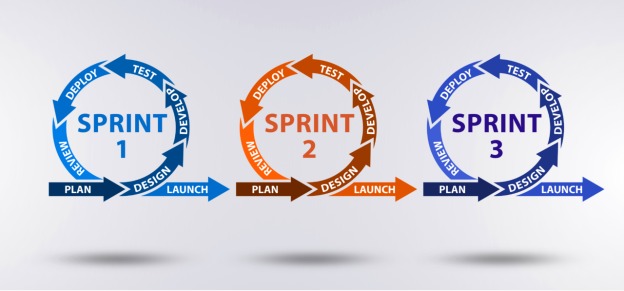The Agile method of software development attempts to keep pace with the evolving demands of customers. By focusing on both business value and high-end technical performance, it offers the most essential features first.
Agility differs from more traditional methods of creating software, like waterfall or plan-driven methods, where the requirements are defined in a single step before writing any code, which can lead to many bugs being discovered after a significant amount of development time has been completed.
When compared to the waterfall model, agile software development is proven to be more effective and flexible. It allows for flexibility as business needs change, such as cost savings, improved customer satisfaction, and shorter delivery times.
The benefits of agile software development for businesses
In the beginning, the major benefits that agile software Development Company can bring to businesses are measurable and well-known. These include improvements in the productivity of developers, more adaptable planning, enhanced quality of the code, and reduced conflict between deployment and integration.
When it comes to rapid software development in business, it is measured by the level of satisfaction the customer has with the product they receive as well as by the stage at which it is created. This means that the achievement of expectations does not occur because you have met the business objectives or reached milestones. They happen because you present the stakeholders with incremental results every few weeks during the sprint review or planning, where they are able to decide to approve new features based on the results they have seen so far and then look towards the next sprint using the agile methodology of development.
#1: Constantly learning and receiving feedback
In agile, the regular interactions between teams and businesses allow everyone to learn from one another. Continuous feedback loops ensure that we’re constantly fixing errors and changing the strategy in response to feedback. Continuous delivery is definitely helpful in this process.
This means that teams can be more productive and have fewer risks of delivering low-quality products, and they often provide more value in a shorter time as well as within the budget.
Agile teams can quickly adapt and learn by incorporating feedback from management throughout their work.
#2: Less risk
Utilizing agile processes boosts efficiency with less risk. The processes also reduce errors, and clients are happy with the continuous deployment. Interested parties are satisfied by releasing the public version regularly and early, as sustainable development leads to healthy ecosystems.
Agile software development services are where user feedback is an important factor in deciding whether new features are released or not. In the waterfall model, there’s more risk because once you begin investing in a stage, it’s extremely difficult to stop or alter the process.
The most crucial aspect of agile software services is that it ensures that the final product is launched promptly and frequently, which allows for continuous feedback so that problems can be addressed as they arise. In waterfall projects, huge portions of work are finished before any feedback from the customer is received, which results in a huge amount of work having to be altered in order to meet customer requirements.
Agile allows for making adjustments throughout the process instead of waiting for the entire process to be developed and then finding out that something is missing. When they see their feedback being taken into consideration, early managers gain more confidence in the processes of agile.
Due to the reduced risk and time needed to make plans for flexible software development company, there’s more chance to modify the software in response to the needs of customers without incurring any additional expenses that can result in greater quality software.
#3: Better cost-efficiency
In the field of software development services, where it is used, agile stands out as the most thorough method, taking into account the uncertainty of business goals and the needs of customers. By doing this, companies can react rapidly to changes in the demands of customers and give themselves a competitive edge. Furthermore, there are enormous savings on work produced using quality assurance. Fixing mistakes discovered later will take less time because they could be found at a later stage in the development of code in the absence of agile, which would have allowed it to quickly change direction by incorporating feedback from stakeholders or customers.
Agile techniques can be designed to be more adaptable and flexible, which means you are able to change your approach as you go along without additional expenses or delays. Thus, high-quality deliverables can result because changes are only required as needed rather than at every phase of the development.
Customers can plan their requirements better in the context of agile software development if they have an idea of what they can expect from the team. In addition, it is beneficial for agile teams since it means there’s less pressure after sprints have ended and customers are awaiting new enhancements or bug fixes that haven’t yet been created but are needed to meet the needs of customers.
Agile methodologies are cost-effective as well as flexible because they allow for continual deployment, even throughout the lifecycle of agile software development. This allows you to make adjustments quickly without the expense of additional time spent writing documents, planning and implementing new features for your product, participating in advanced development cycles, studying user stories, etc.
#4: Minimize complexity
It reduces the complexity of the lifecycle of software development and is one of the advantages of agile development. The central team of programmers isn’t required to create, test, and manage everything in one go. Instead, smaller teams are working on different parts of the project simultaneously while doing their own work and then passing it to another group (or looping back and forth to correct any issues that are discovered).
This means that people are allowed to make mistakes without a lot of worry. The program also encourages owners of products, as well as developers and owners, to embrace adjustments because they worry that they’ll be unable to satisfy everyone. Additionally, it provides more clarity on what you’re getting for your time and money in the backlog of product development.
Because agile software development projects are decentralized, it’s possible to disperse the work across several teams that are working at the same time instead of delivering everything at once. As a result of the prompt feedback, higher-quality products will be delivered, resulting in higher customer satisfaction.
#5: More predictability
Because of Agile software development’s iterative process, project teams tend to be completed on time, within budget, and with a better quality product than they would be without it. It’s because, throughout the integrated process, all elements are designed and tested instead of being implemented blindly by different programmers at various time points in a linear way.
The feedback loop is close, ensuring that there’s no scope creep or major variations between stages of creating an item. Software development that is agile fosters accountability, which encourages employees to stay aware of every little detail.
A flexible software development process in a team that is cross-functional is the best solution if you need to boost your efficiency in workflow and quality.







